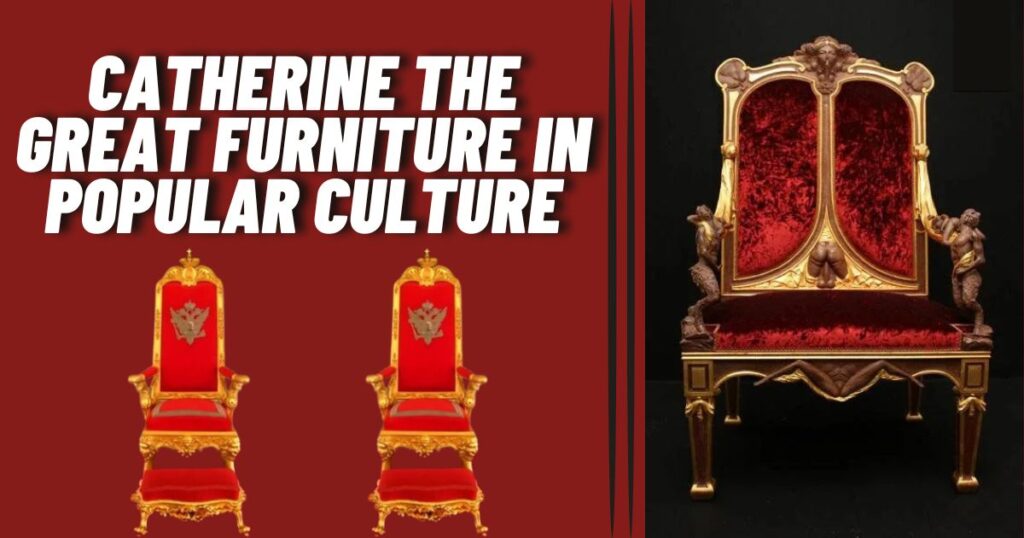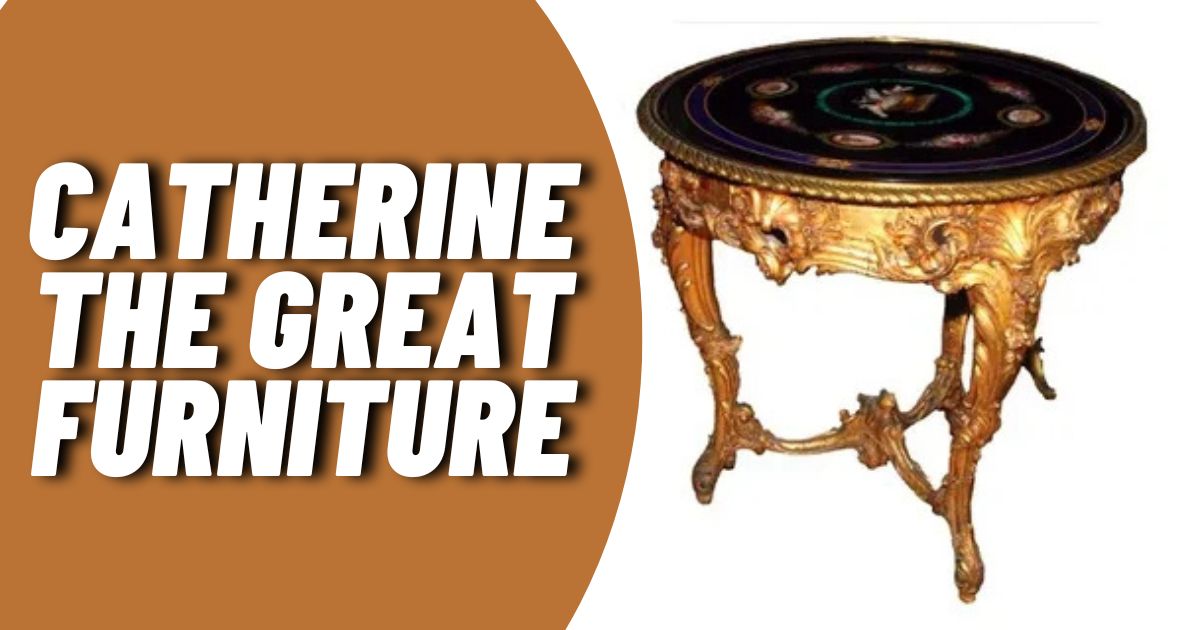Introduction: The Empress’s Lasting Legacy in Furniture Design
When we think of Catherine the Great, the Empress of Russia from 1762 to 1796, we often picture a powerful ruler who transformed her adopted country. But there’s another fascinating aspect of her reign that continues to captivate historians and art enthusiasts alike: her furniture. Catherine the Great’s furniture collection is not just a testament to her taste and wealth, but a window into the artistic and cultural zeitgeist of 18th-century Russia.
Born Sophie Friederike Auguste von Anhalt-Zerbst, Catherine’s journey from German princess to Russian Empress is as intriguing as the furniture she left behind. Her reign, marked by expansion, enlightenment, and artistic patronage, gave rise to a unique blend of Russian grandeur and European elegance in furniture design.
The Influence of Catherine the Great on Furniture Design
Catherine’s passion for the arts and craftsmanship led to a renaissance in Russian furniture design. She commissioned pieces that were not only beautiful but also innovative, reflecting her forward-thinking approach to governance and culture.
Key aspects of Catherine the Great’s furniture influence:
- Fusion of Russian and European styles
- Emphasis on functionality alongside aesthetics
- Personal involvement in design processes
- Patronage of both local and foreign artisans
One of the most striking examples of Catherine’s influence is her famous mechanical table. This marvel of 18th-century engineering could transform to serve multiple purposes, showcasing both the technological prowess and artistic flair of her reign.
“The mechanical table is not just furniture; it’s a symbol of Russia’s embrace of Enlightenment ideals under Catherine’s rule,” notes Dr. Irina Petrova, curator at the Hermitage Museum.
Rumors and Legends: The X-Rated Furniture of Catherine the Great
No discussion of Catherine the Great’s furniture would be complete without addressing the persistent rumors of her alleged erotic furniture collection. These tales, which have persisted for centuries, speak to the complex legacy of a powerful woman in a male-dominated era.
The legend of Catherine’s x-rated furniture includes:
- A secret suite of rooms filled with erotic art and furniture
- Chairs and tables adorned with explicit carvings
- Hidden mechanical devices with salacious purposes
While these stories have captured the public imagination, it’s important to note that there is little historical evidence to support them. The persistence of these legends says more about societal attitudes towards powerful women than it does about Catherine’s actual furniture collection.
Catherine’s Bedroom: Myth vs. Reality

Catherine the Great’s bedroom has been a subject of much speculation, often tied to the rumors of her erotic furniture. However, historical records paint a different picture.
Catherine’s actual bedroom at the Winter Palace:
- Decorated in the height of 18th-century luxury
- Featured elegant, but not overtly erotic, furnishings
- Served as both a private space and a symbol of imperial power
The contrast between the myths surrounding Catherine’s bedroom and the historical reality highlights the importance of critical analysis when examining historical claims.
The Wehrmacht’s Controversial Discovery
In 1941, during the Nazi invasion of the Soviet Union, two Wehrmacht officers allegedly discovered a collection of erotic furniture in one of Catherine’s palaces. This claim reignited interest in the legends surrounding Catherine’s furniture.
Key points about the Wehrmacht discovery:
- Occurred during the chaos of World War II
- Details of the discovery remain vague and unverified
- Highlights the challenges of historical preservation during wartime
The veracity of this discovery remains a topic of debate among historians, underscoring the complex relationship between historical fact and legend.
French Influence on Catherine’s Furniture Collection
Catherine’s admiration for French culture had a profound impact on her furniture collection. She invited French artisans to her court, leading to a unique fusion of French rococo and Russian imperial styles.
Notable French contributions to Catherine’s collection:
- Intricate marquetry and gilt bronze decorations
- Elegant cabinetry and seating designs
- Integration of neoclassical elements
This cultural exchange not only enriched Catherine’s personal collection but also had a lasting impact on Russian furniture design for generations to come.
The Lasting Impact of Catherine the Great’s Furniture on Russian Culture
Catherine the Great’s furniture legacy extends far beyond the pieces themselves. Her patronage of the arts and emphasis on blending functionality with beauty influenced Russian culture in profound ways.
Cultural impacts of Catherine’s furniture legacy:
- Elevated status of furniture design as an art form
- Inspired future generations of Russian craftsmen
- Contributed to Russia’s reputation for luxury and grandeur
Today, Catherine’s furniture remains a source of pride and fascination, preserved in museums and palaces across Russia.
Read This Post: Agrawau: Unveiling the Rich Tapestry of Cultural Significance
The Mechanical Marvels of Catherine’s Collection
Catherine the Great’s fascination with innovation and technology was prominently displayed in her furniture collection, particularly through her mechanical tables and chairs. These pieces weren’t just luxurious; they were functional works of art that showcased the pinnacle of 18th-century craftsmanship and engineering.
One of the most famous examples is the Peacock Clock, which, while not strictly furniture, exemplifies Catherine’s love for mechanical wonders. This elaborate automaton, featuring a peacock, owl, and rooster, still functions today in the Hermitage Museum.
Notable features of Catherine’s mechanical furniture:
- Tables that could be transformed for different purposes (writing, dining, gaming)
- Chairs with hidden compartments and adjustable features
- Desks with intricate locking mechanisms and secret drawers
- Furniture pieces that could be easily transported and reassembled
These mechanical marvels weren’t just for show. They reflected Catherine’s practical mind and her desire to bring the latest European innovations to Russia.
“Catherine’s mechanical furniture represented the perfect marriage of art and science, a physical manifestation of Enlightenment ideals,” explains Dr. Alexei Volkov, a historian specializing in 18th-century Russian material culture.
The Infamous Suite of Rooms: Fact or Fiction?

The legend of Catherine the Great’s secret suite of rooms, allegedly filled with erotic furniture and art, has persisted for centuries. While there’s little concrete evidence to support these claims, the story itself provides fascinating insights into how historical narratives are shaped and perpetuated.
Factors contributing to the persistence of this legend:
- Catherine’s reputation as a passionate and powerful woman
- Societal discomfort with female sexuality and power
- The allure of scandal and secrecy in royal courts
- Misinterpretation or exaggeration of historical accounts
It’s crucial to approach these stories with a critical eye, understanding that they often reveal more about the society that perpetuates them than about the historical figures they describe.
French Artisans at the Russian Court
Catherine’s admiration for French culture led her to invite numerous French artisans to her court. This cultural exchange had a profound impact on Russian furniture design and craftsmanship.
Notable French artisans who worked for Catherine:
- Jean-Baptiste Greuze (painter)
- Étienne Maurice Falconet (sculptor)
- Charles Cameron (architect and furniture designer)
- Jean-François Chalgrin (architect)
These artists brought with them the latest French styles, including Rococo and Neoclassical elements, which were then adapted to suit Russian tastes and traditions.
The Impact on Russian Culture and Design
Catherine the Great’s furniture collection did more than just decorate her palaces; it helped shape the course of Russian design and cultural identity for generations to come.
Long-term impacts of Catherine’s furniture legacy:
- Establishment of furniture-making schools and workshops in Russia
- Elevation of furniture design as a respected art form
- Integration of Western European and traditional Russian aesthetics
- Influence on future imperial and aristocratic tastes
Even today, the furniture styles popularized during Catherine’s reign continue to inspire Russian designers and artisans, serving as a bridge between Russia’s imperial past and its modern design scene.
Preserving Catherine’s Legacy: Modern Conservation Efforts
The preservation of Catherine the Great’s furniture is an ongoing effort that combines cutting-edge technology with traditional restoration techniques.
Current conservation methods include:
- 3D scanning and modeling to create detailed digital archives
- Non-invasive material analysis to inform restoration decisions
- Climate-controlled storage and display environments
- Collaboration between international experts to share best practices
These efforts ensure that future generations can continue to study and appreciate the craftsmanship and historical significance of Catherine’s furniture collection.
Catherine the Great Furniture in Popular Culture

The allure of Catherine’s furniture, especially the rumors surrounding her erotic collection, has made its way into popular culture, appearing in books, films, and television shows.
Examples of Catherine’s furniture in media:
- The 2020 series “The Great” features stylized versions of Catherine’s opulent furnishings
- Dan Brown’s novel “The Da Vinci Code” makes reference to Catherine’s legendary erotic furniture
- Various documentaries have explored the myths and realities of Catherine’s collection
While these portrayals often prioritize sensationalism over historical accuracy, they demonstrate the enduring fascination with Catherine the Great and her material legacy.
Conclusion
Catherine the Great’s furniture collection stands as a testament to her reign’s emphasis on cultural refinement, technological innovation, and artistic patronage. From the practical ingenuity of her mechanical tables to the persistent legends of secret erotic chambers, each piece tells a story of a ruler who understood the power of material culture in shaping a nation’s identity.
As we continue to study and admire these artifacts, we gain not just an appreciation for exquisite craftsmanship, but a deeper understanding of the complex interplay between power, art, and cultural exchange in 18th-century Europe. Catherine’s furniture legacy, like her reign, continues to captivate historians, art enthusiasts, and the general public alike, proving that true innovation and artistry can indeed stand the test of time.
In the end, Catherine the Great’s furniture is more than just a collection of beautiful objects. It’s a tangible link to a transformative period in Russian history, a reflection of a visionary ruler’s ambitions, and a continuing source of inspiration for artists and designers around the world.
Catherine the Great’s furniture collection tells a story of power, artistry, and cultural exchange. From the innovative mechanical tables to the persistent legends of erotic furnishings, each piece offers a glimpse into the complex world of 18th-century Russian imperial life.
As we continue to study and admire these pieces, we gain not just an appreciation for fine craftsmanship, but a deeper understanding of a pivotal era in Russian history. Catherine’s furniture, like her reign, continues to captivate and inspire, proving that true artistry stands the test of time.
Key Takeaways
- Catherine the Great’s furniture blended Russian grandeur with European elegance
- Innovative designs, like the mechanical table, showcased technological progress
- Legends of erotic furniture persist, despite lack of solid historical evidence
- French artisans played a crucial role in shaping Catherine’s collection
- The furniture legacy of Catherine the Great continues to influence Russian culture
FAQs
What was Catherine the Great’s furniture like?
Catherine’s furniture was a blend of Russian imperial style and French elegance, featuring innovative designs like mechanical tables and luxurious materials.
Why was Catherine the Great important in history?
Catherine was a pivotal ruler who expanded Russia’s borders, patronized the arts, and brought Enlightenment ideas to her adopted country.
What is the most interesting thing about Catherine the Great?
While opinions vary, many find her rise from German princess to Russian Empress and her cultural impacts, including her furniture legacy, particularly fascinating.
What was Catherine the Great notorious for?
Catherine was known for her political acumen, cultural patronage, and unfortunately, persistent rumors about her personal life, including tales of erotic furniture.
Why was Catherine the Great unique for her time?
As a female ruler in the 18th century, Catherine’s emphasis on education, the arts, and modernization set her apart from many of her contemporaries.

Welcome to the heart of our website! The Admin Dashboard is your command center, where you can manage all aspects of the site effortlessly. Here, you’ll find intuitive tools for content management, user analytics, and system settings. Customize, control, and optimize your site experience with a few clicks. Whether you’re updating content, monitoring traffic, or fine-tuning user permissions, everything you need is right at your fingertips. Dive in and take charge!









